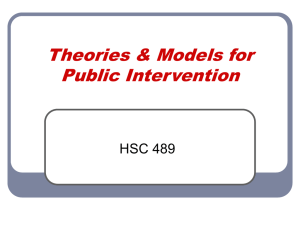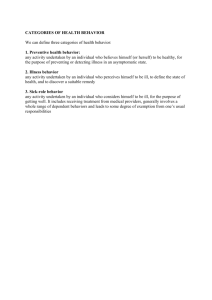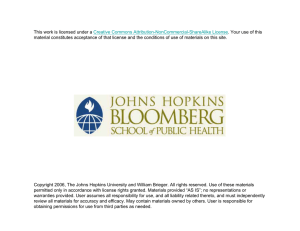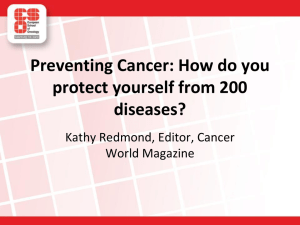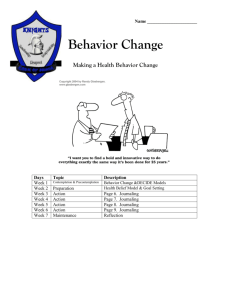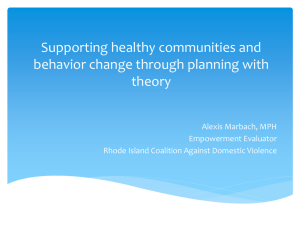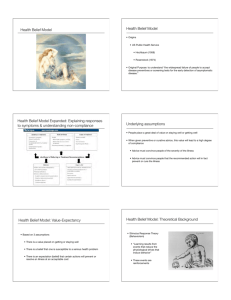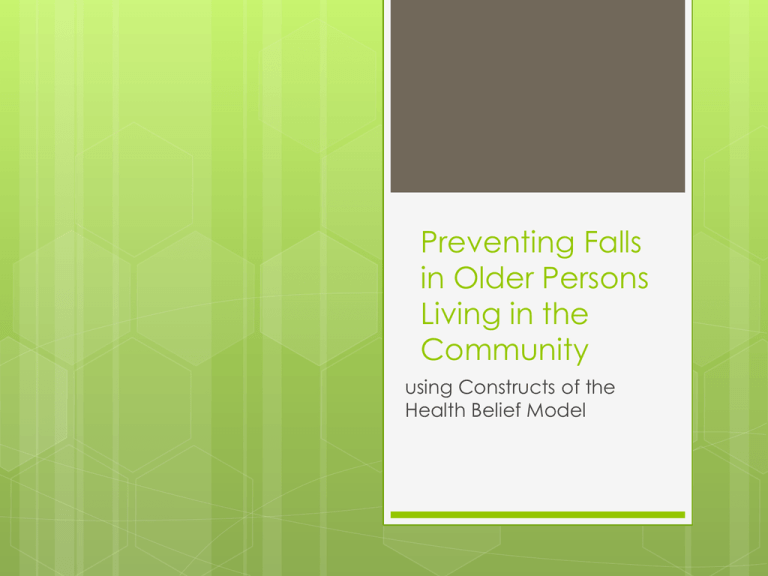
Preventing Falls
in Older Persons
Living in the
Community
using Constructs of the
Health Belief Model
“Falls prevention is a
challenge to population
aging.”
WHO
Falls are the second leading cause of accidental
or unintentional injury deaths in older persons.(WHO,
2007)
In 2000, direct medical costs for fatal and
nonfatal fall injuries in the United States
totaled over $19 billion (CDC, 2008).
For older persons, falls result in increased
dependence, loss of autonomy, confusion,
immobilization, depression, and restriction in
daily activities.
Falling
without serious injury increases the
risk of skilled nursing facility placement by
three-fold.
Falling with a serious injury increases SNF
placement by ten-fold.
Falls are associated with
admission to a nursing care
facility.
Reduce the rate of emergency
department visits due to falls among
older adults
2007
– 5,235.1 ed visits per 100,000
13,580 ed visits per 100,000 >85 years
Target for 2020 – 10% improvement –
4,711.6 ed visits per 100,000
Healthy People 2020
older adults: objective 11
Previous
falls
Balance, gait, and strength impairment
Use of specific medications
Female gender
White race
Visual impairment
Tremor
Incontinence
Limitations in activities of daily living
Environmental hazards
Risks for falling
All older persons who are under the care
of a health professional (or their
caregivers) should be asked at least
once a year about falls, frequency of
falling, and difficulties in gait or balance
(AGS & BGS, 2011, p. 149-150).
Screening
Interventions
single
Cardiac
pacing
Vision improvement
Home modifications
Medication reduction
Physical therapy or exercise
Multifactorial/targeted
Balance, gait, and strength training such as
tai chi
Modifying the home to promote safe
performance of ADLs
Treating vision impairment
Minimizing medications
Managing postural hypertension
Managing heart rate and rhythm
Correcting vitamin D deficiency
Managing foot and footware problems
What’s the problem?
Health Belief Model
1950’s
Hochbaum, Rosenstock, and Kegels
Developed in response to the failure of a free
TB health screening program
Most used theory in health education and
health promotion
Used to explore a variety of short and longterm health behaviors, including sexual risk
behaviors and transmission of HIV/AIDS
Original Theoretical Constructs
Perceived
seriousness
Perceived
susceptibility
Perceived
benefits
Perceived
barriers
Perceived seriousness
Belief
about the
seriousness or
severity of a
disease
Based on medical
information or
knowledge
Perceived susceptibility
One’s
opinion of chances of getting a
condition
Prompts
men who have sex with men to
use condoms in an effort to decrease
susceptibility to HIV infection.
A perception of increased
susceptibility or risk is linked to
healthier behaviors
Decreased susceptibility to
unhealthy behaviors
Not always the case – explains
behavior in some cases, but
not all.
Perceived benefits
People
adopt healthier behaviors when
they believe the behavior will decrease
their risk of developing a disease
Plays an important role in adoption of
secondary prevention behaviors
Colon cancer screening
BSE
Perceived barriers
One’s
perception of the tangible and
psychological obstacles or costs in the
way of him/her adopting a new behavior
The most significant construct in
determining behavior change
Hispanic women seeking pap tests
Painful
Not
knowing where to go
Cues to Action
Strategies
to activate readiness
Examples include illness of a family
member, media reports, mass media
campaigns, advice from others, reminder
postcards from a health care provider, of
health warning labels on a product
Self-efficacy
Added
to the four original constructs in
1988
The belief in one’s own ability to do
something (Bandura, 1977)
A significant factor in not performing BSE is
fear of being unable to perform it correctly
Exercise self-efficacy and exercise barriers
are the strongest predictors of whether one
practices behaviors to prevent osteoporosis
Application
“I pass with relief from the tossing sea of
Cause and Theory to the firm ground of
Result and Fact.” Winston Churchill
Health Belief Model
Concept
Definition
Potential change
strategies
Perceived
susceptibility
Beliefs about the
chances of
getting a
condition
Define what
population (s) are at
risk and their levels of
risk
Perceived severity
Beliefs about the
seriousness of a
condition and its
consequences
Specify the
consequences of a
condition and
recommended action
Perceived benefits Beliefs about the
effectiveness of
taking action to
reduce risk or
seriousness
Explain how, where,
and when to take
action and what the
potential positive
consequences will be
Concept
Definition
Potential change strategies
Perceived
barriers
Beliefs about
the material
and
psychological
costs of taking
action
Offer reassurance,
incentives, and assistance;
correct misinformation
Cues to action
Factors that
activate
“readiness to
change”
Provide how to information,
promote awareness, and
employ reminder systems
Self-efficacy
Confidence in
one’s ability
• Provide training and
guidance
• Use progressive goal
setting
• Give verbal reinforcement
• Demonstrate desired
behaviors
Theory in action: activity
Using the HBM, brainstorm to identify strategies
to address
1. Perceptions of seriousness
2. Perceptions of susceptibility
3. Perceived Benefits
4. Perceived Barriers
5. Self-efficacy
that might be used to develop a falls prevention
program for older persons living in the
community.
References
1.
2.
3.
Champion, V.L. & Scott, C.R. (1997).
Reliability and validity of breast cancer
screening belief scales in African American
women. Nursing Research, 46(6), 331-337.
Chen, J. Y., Fox, S.A., Cantrell, C.H.,
Stockdale, S.E., & Kagawa-Singer, M. (2007).
Health disparities and prevention: racial
ethnic barriers to flu vaccinations. Journal of
Community Health, 32(1), 5-21.
Glanz, K. & Rimer, B.K. (2005). Theory at a
Glance: A Guide for Health Promotion
Practice. National Institute of Health.
4.
5.
6.
Gozum, S. Karayurt, O, Kav, S., & Platin, N.
(2010). Effectiveness of peer education for
breast cancer screening and health beliefs
in eastern Turkey. Cancer Nursing, 33(3), 213220.
Hayden, J.A. (2009) Health belief model. In
Introduction to Health Behavior Theory.
Burlington, MA: Jones & Bartlett.
Turner, l.W., Hunt, S.B., DiBresso, R., & Jones,
C. (2004). Design and implementation of an
osteoporosis prevention program using the
health belief model. American Journal of
Health Studies, 19(2), 115-121.
American Geriatrics Society and British Geriatrics Society. Panel on
Prevention of Falls in Older Persons (2011). Summary of the updated
American Geriatrics Society and British Geriatrics Society clinical practice
guideline for prevention of falls in older persons. Journal of the American
Geriatrics Society, 59 (1), 148-157.
Centers for Disease Control and Prevention (CDC). (2008). Self reported
falls and fall-related injuries among persons aged >65 years – United
States, 2006. Morbidity and Mortality Weekly Report, 57(9), 225-229.
Mahoney, J. E. (2010). Why multifactorial fall-prevention interventions
may not work. Archives of Internal Medicine, 170(13), 1117-1119.
Nardi, D. A., & Petr, J. M. (2003). Community health and wellness needs
assessment. Clifton Park, NY: Delmar Learning.
Tinetti, M. E., & Kumar, C. (2010) The patient who falls. The Journal of the
American Medical Association, 303(3), 258-266. doi:
10.1001/jama.2009.2024
U.S. Department of Health and Human Services. (n.d.) Healthy People
2020. Washington, D.C. Retrieved from
http://www.healthypeople.gov/2020/topicsobjectives2020
World Health Organization (WHO). (2007). WHO global report on falls
prevention in older age. Geneva, Switzerland: Author. Retrieved from
http://www.who.int/ageing/publications/Falls-prevention7March.pdf
Yamashita, T., Jeon, H., Bailer, A. J., Nelson, I. M., & Mehdizadeh, S. (2011).
Fall risk factors in community dwelling elderly who receive medicaid
supported home and community cased care services. Journal of Aging
and Health, 23(4), 682-703. doi: 10.1177/0898264310390941


